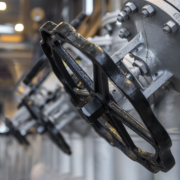Oxidation of mineral and synthetic thermal oil – Corrosion in the system damages plant components
After we have previously discussed light-ends and the Conradson value, this time we would like to address oxidation in thermal oils, what causes it and how to counteract it.
As we have previously seen with the other topics of “light-ends” and “Conradson value”, chemical reactions continuously take place in thermal oil. On the one hand, this leads to the formation of the previously mentioned light-ends, or to solid components in oil, which in turn can be determined by the Conradson value. A third reaction chain within the oil can lead to the formation of organic acids. This requires the presence of oxygen and moisture, as they are found in the ambient air. As we already know, thermal oil consists mostly of hydrocarbon compounds. At high temperatures, these react with the oxygen present to form carboxylic acids. As intermediate products, alcohols and aldehydes are formed.
As the name carboxylic acids suggests, these components in the oil are corrosive, which in turn leads to damage on tanks. The open drain tanks and expansion tanks are particularly affected, since these are directly in contact with atmospheric oxygen and the acids cause corrosion on the inner walls. The proportion of acids formed can be determined by the acid number (or the neutralisation number) through doing an oil analysis.
“This process is prevented by a nitrogen blanket. The drain tank and expansion tank are “blanketed” with nitrogen. This means that they are filled with inert gas – in this case nitrogen – at a slight excess pressure. With this, the atmospheric oxygen, as well as the moisture within in it, is suppressed and the oxidation is prevented,” Dietmar Ness explains, one of the Managing Directors of NESS Wärmetechnik GmbH, in relation to this topic. “Another advantage that should not be underestimated is that the nitrogen prevents explosive gas mixtures from forming in the expansion and drain tanks.”
With some nitrogen blankets, only the expansion tank is covered. The additional blanketing of the drain tank reduces the risk of fire. If there is no flammable gas in the tanks, nothing can explode. The additional blanketing of another large tank also results in a larger volume of nitrogen overall. A larger volume of nitrogen cushions the pressure variation in the system much more effectively, which in turn must be released from the system or refilled less frequently. In the long-term, this saves significant amounts of nitrogen and therefore money too.
“The integration into new as well as existing systems is very easy to do” says Dietmar Ness. “It was also important to us that the nitrogen blanket also works fully automatically. In order to ensure that sufficient nitrogen is available, a nitrogen generator can be additionally integrated. This also extracts the nitrogen from compressed air fully automatically. In doing so, a membrane is used, which only lets nitrogen molecules from the ambient air through and therefore separates the nitrogen from the other components in the air, such as oxygen, argon and CO2. This, therefore, provides a virtually unlimited supply of nitrogen. Maximum effect with minimal effort”.














